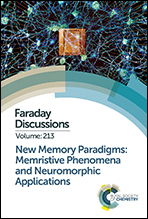Structural transition pathway and bipolar switching of the GeTe–Sb2Te3 superlattice as interfacial phase-change memory†
Abstract
We investigated the resistive switching mechanism between the high-resistance state (HRS) and the low-resistance state (LRS) of the GeTe–Sb2Te3 (GST) superlattice. First-principles calculations were performed to identify the structural transition pathway and to evaluate the current–voltage (I–V) characteristics of the GST device cell. After determining the atomistic structures of the stable structural phases of the GST superlattice, we found the structural transition pathways and the transition states of possible elementary processes in the device, which consisted of a thin film of GST superlattice and semi-infinite electrodes. The calculations of the I–V characteristics were examined to identify the HRS and the LRS, and the results reasonably agreed with those of our previous study (H. Nakamura, et al., Nanoscale, 2017, 9, 9286). The calculated HRS/LRS and analysis of the transition states of the pathways suggest that a bipolar switching mode dominated by the electric-field effect is possible.

- This article is part of the themed collection: New memory paradigms: memristive phenomena and neuromorphic applications


 Please wait while we load your content...
Please wait while we load your content...